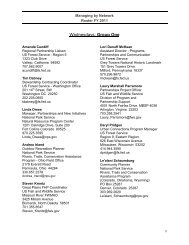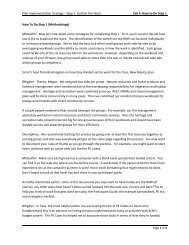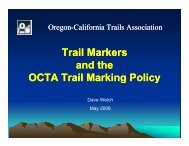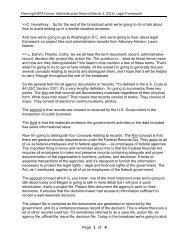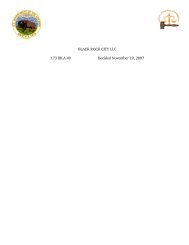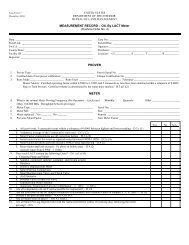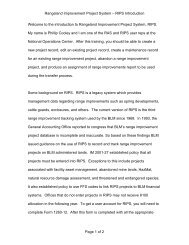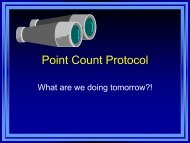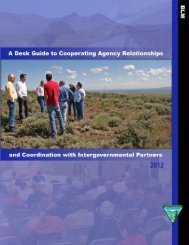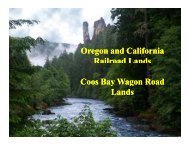H9177-2 - Bureau of Land Management
H9177-2 - Bureau of Land Management
H9177-2 - Bureau of Land Management
You also want an ePaper? Increase the reach of your titles
YUMPU automatically turns print PDFs into web optimized ePapers that Google loves.
BLM Manual Handbook 9177-2<br />
Dam<br />
BLM<br />
Condition<br />
Assessment Checklist<br />
(Public)<br />
BLM Manual Handbook H-9177-2, rev. September 2006
BLM manuals and handbooks are online at:<br />
http://www.blm.gov/nhp/efoia/index.htm<br />
Suggested citation:<br />
<strong>Bureau</strong> <strong>of</strong> <strong>Land</strong> <strong>Management</strong>. 2006. Dam Condition Assessment Checklist. BLM Manual Handbook 9177-2.<br />
Denver, Colorado. Release x-xxxx. 9 sheets.
BLM Manual Handbook 9177-2<br />
Dam<br />
Condition<br />
Assessment Checklist<br />
(Public)<br />
BLM Manual Handbook H-9177-2, rev. September 2006
BLM Manual Handbook H-9177-2<br />
Dam Condition Assessment Checklist (Public)<br />
<br />
NAME OF DAM:<br />
Geographical Data Classification Data Inspector Data<br />
Current Hazard Class (L/S/H):<br />
Date <strong>of</strong> Inspection:<br />
Administrative State: Population at Risk (High Hazard Only): Inspector Name:<br />
Geographic State (if diff):<br />
Weather:<br />
County:<br />
Field Office: Size Class (Minor/Small/Inter/Large): Date <strong>of</strong> Last Inspection:<br />
Section: T: R: Type <strong>of</strong> Dam<br />
(if not earth):<br />
Aliquot Part: Condition Rating Code: 1<br />
Safety issues and warnings for<br />
inspectors:<br />
Latitude at Benchmark (nearest 10th) River/Stream Crossed: Driving Directions to Dam:<br />
Longitude at Benchmark<br />
(nearest 10 th ):<br />
Meridian:<br />
Seismic PGA<br />
(high haz only):<br />
Date Dam Constructed:<br />
BLM ID No.:<br />
Date Dam Modified:<br />
Equip. No.:<br />
Plan/Section Dwg No.:<br />
Notes:<br />
For High Hazard dams, note any low water crossings, private land crossings, locked gates, poor roads, etc:<br />
Describe any development within 3 miles downstream since the last inspection. If none, write “None”:<br />
Describe any active County, State, or Federal roads, active railroads, or utilities within 3 miles downstream. If none, write<br />
“None.” For County roads, list the number <strong>of</strong> vehicles per day:<br />
1 Condition Rating Code (See Appendix). Give numeral (0–9) and discriptive term (good, poor,etc.).<br />
BLM MANUAL<br />
Supersedes Rel. 1-xxxx<br />
Rel. x-xxx<br />
xx/xx/xx
BLM Manual Handbook H-9177-2<br />
Dam Condition Assessment Checklist (Public)<br />
Dimensional Data<br />
Benchmark Elevation:<br />
Station ____________<br />
A<br />
Slope <strong>of</strong> Upstream Face (H:V):<br />
O<br />
Dam Crest Elevation<br />
(max):<br />
Station ____________<br />
B<br />
Principal Spillway Outlet<br />
Invert Elevation:<br />
Station ___________<br />
P<br />
Dam Crest Elevation<br />
(minimum):<br />
Station ____________<br />
C<br />
Principal Spillway Outlet Diameter:<br />
Q<br />
Emergency Spillway Crest<br />
Elevation:<br />
Station ____________<br />
D<br />
Low-Level Gated Outlet<br />
Outlet Invert Elevation:<br />
Station ___________<br />
R<br />
Principal Spillway Inlet<br />
Invert Elevation:<br />
Station ____________<br />
E<br />
Lowest Point on the<br />
Downstream Toe<br />
Elevation:<br />
Station ___________<br />
S<br />
Principal Spillway Inlet (Riser) Diameter:<br />
F<br />
Distance From Centerline <strong>of</strong> Dam to Outlet <strong>of</strong><br />
Principal Spillway:<br />
T<br />
Principal Spillway Material: (m/c/p)<br />
Distance From Centerline <strong>of</strong> Dam to Outlet <strong>of</strong><br />
Low-Level Gated Outlet:<br />
U<br />
Principal Spillway Drop Inlet Height (Riser):<br />
G<br />
Distance From Centerline <strong>of</strong> Dam to Lowest Point on<br />
Downstream Face:<br />
V<br />
Water Level at Survey<br />
Date Elevation:<br />
Station ____________<br />
H<br />
Slope <strong>of</strong> Downstream Face (H:V):<br />
W<br />
Lowest Point on the Upstream Toe Elevation:<br />
I<br />
Crest Width:<br />
Station ___________<br />
X<br />
Low-Level Gated Outlet<br />
Inlet Invert Elevation:<br />
Station ____________<br />
J<br />
Dam Crest Length Along Centerline <strong>of</strong> the Dam:<br />
Y<br />
Low-Level Gated Outlet Diameter:<br />
K<br />
Emergency Spillway Width at the Crest:<br />
Z<br />
Low-Level Gated Outlet Material: (m/c/p)<br />
Emergency Spillway Length at the Crest:<br />
AA<br />
Distance From Centerline <strong>of</strong> Dam to Inlet <strong>of</strong> Low-<br />
Level Gated Outlet:<br />
L<br />
Emergency Spillway Sideslope on Left (H:V):<br />
BB<br />
Distance From Centerline <strong>of</strong> Dam to Lowest Point on<br />
Upstream Face:<br />
M<br />
Emergency Spillway Sideslope on Right (H:V):<br />
CC<br />
Distance From Centerline <strong>of</strong> Dam to Inlet <strong>of</strong> Principal<br />
Spillway:<br />
N<br />
Reservoir Surface Area (Acres) at Emergency Spillway<br />
Crest:<br />
DD<br />
BLM MANUAL<br />
Supersedes Rel. 1-xxxx<br />
Rel. x-xxx<br />
xx/xx/xx
BLM Manual Handbook H-9177-2<br />
Dam Condition Assessment Checklist (Public)<br />
<br />
Calculated Data<br />
Calc1. Hydraulic Height (D-S):<br />
Calc7. Principal Spillway Outlet Pipe Length (T+N):<br />
Calc2. Structural Height (B-S):<br />
Calc8. Low-Level Gated Outlet Pipe Length (U+L):<br />
Calc3. Minimum Freeboard<br />
(C-D):<br />
Calc9. Estimated Max Reservoir Storage ((DD û Calc6.) / 3) :<br />
Calc4. Normal Storage Depth<br />
(E-I):<br />
Calc10. Volume <strong>of</strong> Embankment:<br />
(((Calc2. û Y) û (X + ((Calc2. û O)/2] + ((Calc2. û W)/2))) / 54)<br />
Calc5. Actual Storage Depth<br />
(H-I):<br />
Other:<br />
Calc6. Maximum Storage Depth<br />
(D-I):<br />
Other:<br />
Notes:<br />
See Figure for definition <strong>of</strong> dimensions.<br />
Indicate all dimensions in feet unless otherwise noted.<br />
If reservoir is dry at time <strong>of</strong> inspection, actual storage depth is 0.<br />
Datum for permanent benchmark shall be elevation 100’.<br />
For Calc10. dimensions O and W are slope ratios and all other parameters are in feet. The answer is in cubic yards.<br />
Inspector Signature<br />
Date<br />
BLM MANUAL<br />
Supersedes Rel. 1-xxxx<br />
Rel. x-xxx<br />
xx/xx/xx
BLM Manual Handbook H-9177-2<br />
Dam Condition Assessment Checklist (Public)<br />
NAME OF DAM: ______________________________ DATE INSPECTED: __________________<br />
Figure. Definition <strong>of</strong> Dimensions.<br />
Notes:<br />
Show location on the Plan View <strong>of</strong> Station 0+00.<br />
Use the back <strong>of</strong> this page to draw a plan view sketch <strong>of</strong> the reservoir and dam (DD).<br />
BLM MANUAL<br />
Supersedes Rel. 1-xxxx<br />
Rel. x-xxx<br />
xx/xx/xx
BLM Manual Handbook H-9177-2<br />
Dam Condition Assessment Checklist (Public)<br />
<br />
DAM CONDITION ASSESSMENT CHECKLIST<br />
NAME OF DAM: ______________________________ DATE INSPECTED: __________________ Directions:<br />
1 Check the N/A, YES/NO, or Corrective Action Recommended (CAR 1 ) columns as required.<br />
2 Use the same flag number if quantities for similar items will be calculated and grouped together in the<br />
Recommended Work Summary.<br />
3 Use item numbers to identify items on the Recommended Work Summary.<br />
Item<br />
No.<br />
Item N/A Y N<br />
CAR 1<br />
RIM<br />
Flag<br />
No.<br />
Remarks<br />
EMBANKMENT<br />
1. CREST<br />
a. Any visual settlements<br />
b. Cracking<br />
c. Lateral movement<br />
d. Visible sinkhole<br />
e. Erosion<br />
f. Trees & brush<br />
g. FAMS road on crest<br />
h. Rodent holes<br />
2. UPSTREAM SLOPE<br />
a. Erosion<br />
b. Trees & brush<br />
c. Longitudinal cracks<br />
d. Transverse cracks<br />
e. Visual depression or bulges<br />
f. Visual settlements<br />
g. Visible sinkhole<br />
h. Debris<br />
i. Rodent holes<br />
3. DOWNSTREAM SLOPE<br />
a. Erosion<br />
b. Trees & brush<br />
c. Longitudinal cracks<br />
d. Transverse cracks<br />
e.<br />
Visual depressions or<br />
bulges<br />
f. Visual settlements<br />
g. Visible sinkhole<br />
h. Boils present at toe<br />
BLM MANUAL<br />
Supersedes Rel. 1-xxxx<br />
Rel. x-xxx<br />
xx/xx/xx
BLM Manual Handbook H-9177-2<br />
Dam Condition Assessment Checklist (Public)<br />
Item<br />
No.<br />
i. Seepage present<br />
j. Rodent holes<br />
k. Is toe drain dry<br />
4. ABUTMENT CONTACTS<br />
a. Erosion<br />
b. Visual differential movement<br />
c. Cracks<br />
d. Seepage present<br />
e. Trees & brush<br />
5. GROIN<br />
a. Erosion<br />
b. Visual differential movement<br />
c. Cracks<br />
d. Seepage present<br />
e. Trees & brush<br />
6. RESERVOIR CONTROL<br />
a. Recent downstream development<br />
b. Slides in reservoir area<br />
c. Change in reservoir operation<br />
d. Other large impoundments u/s<br />
e. Evidence or recreational use<br />
7. INSTRUMENTATION<br />
a. List any instrumentation present<br />
b. Is instrumentation functional<br />
c. Record measurements<br />
Item N/A Y N<br />
CAR<br />
RIM<br />
Flag<br />
No.<br />
(see page 58 <strong>of</strong> Dam Condition Assessment Guidelines for Embankment Dams)—EMBANKMENT SAFETY RATING:<br />
PRINCIPAL SPILLWAY OR OUTLET<br />
8. INTAKE STRUCTURE<br />
a. Debris present<br />
b. Concrete surface condition<br />
(1) Spalling<br />
(2) Cracking<br />
(3) Erosion<br />
(4) Scaling<br />
(5) Exposed reinforcement<br />
(6) Other, list<br />
Remarks<br />
BLM MANUAL<br />
Supersedes Rel. 1-xxxx<br />
Rel. x-xxx<br />
xx/xx/xx
BLM Manual Handbook H-9177-2<br />
Dam Condition Assessment Checklist (Public)<br />
<br />
Item<br />
No.<br />
Item N/A Y N<br />
CAR<br />
RIM<br />
Flag<br />
No.<br />
Remarks<br />
c. Joint condition<br />
(1) Displacement or <strong>of</strong>fset<br />
(2) Loss <strong>of</strong> joint material<br />
(3) Leakage<br />
d. Metal appurtenances<br />
(1) Corrosion present<br />
(2) Breakage present<br />
(3) Anchor system secure<br />
9. CONDUIT<br />
a. Is conduit concrete<br />
b. Concrete surface condition<br />
(1) Spalling<br />
(2) Cracking<br />
(3) Erosion<br />
(4) Scaling<br />
(5) Exposed reinforcement<br />
(6) Displacement or <strong>of</strong>fset<br />
(7) Leakage<br />
(8) Other, list<br />
c. Metal conduit condition<br />
(1) Corrosion present<br />
(2) Protection coating adequacy<br />
(3) Conduit misalignment<br />
(4) Leakage<br />
d. Plastic conduit condition<br />
(1) Displacement or <strong>of</strong>fset<br />
(2) Leakage<br />
(3) Crushed or broken<br />
e. Conduit trashrack condition<br />
(1) Operational<br />
(2) Plugged<br />
(3) Corrosion or damage present<br />
10. GATES<br />
a. Flood gate condition<br />
(1) Broken or bent<br />
(2) Corroded or rusted<br />
BLM MANUAL<br />
Supersedes Rel. 1-xxxx<br />
Rel. x-xxx<br />
xx/xx/xx
BLM Manual Handbook H-9177-2<br />
Dam Condition Assessment Checklist (Public)<br />
Item<br />
No.<br />
Item N/A Y N<br />
CAR<br />
RIM<br />
Flag<br />
No.<br />
Remarks<br />
(3) Regularly maintained<br />
(4) Gates operational<br />
c. Is there a low-level gate<br />
d. Is low-level gate operational<br />
(see page 54 <strong>of</strong> Dam Condition Assessment Guidelines for Embankment Dams)—PRINCIPAL SPILLWAY or<br />
OUTLET WORKS SAFETY RATING:<br />
EMERGENCY SPILLWAY or OUTLET<br />
WORKS<br />
11. STILLING BASIN<br />
a. Concrete surface condition<br />
(1) Spalling<br />
(2) Cracking<br />
(3) Erosion<br />
(4) Scaling<br />
(5) Exposed reinforcement<br />
(6) Other, list<br />
b. Joint condition<br />
(1) Displacement or <strong>of</strong>fset<br />
(2) Loss <strong>of</strong> joint material<br />
(3) Leakage<br />
c. Energy dissipater condition<br />
(1) Deterioration<br />
(2) Covered with debris<br />
(3) Other, list<br />
d. Channel condition<br />
(1) Eroding or backcutting<br />
(2) Sloughing<br />
(3) Obstructed<br />
(4) Undercut by released water<br />
(5) Embankment erosion by water<br />
e. Gabion condition<br />
(1) Corroded<br />
(2) Basket misaligned<br />
(3) Basket settlement<br />
(4) Brush growing in gabions<br />
f. Riprap condition<br />
(1) Erosion undercut or settlement<br />
BLM MANUAL<br />
Supersedes Rel. 1-xxxx<br />
Rel. x-xxx<br />
xx/xx/xx
BLM Manual Handbook H-9177-2<br />
Dam Condition Assessment Checklist (Public)<br />
<br />
Item<br />
No.<br />
Item N/A Y N<br />
CAR<br />
RIM<br />
Flag No.<br />
Remarks<br />
(2) Vegetation<br />
(3) Extent <strong>of</strong> riprap adequacy<br />
(4) Migration <strong>of</strong> riprap<br />
12. SPILLWAY or OUTLET WORKS<br />
a. Spillway concrete condition<br />
(1) Spalling<br />
(2) Cracking<br />
(3) Erosion<br />
(4) Scaling<br />
(5) Exposed reinforcement<br />
(6) Concrete undercut<br />
(7) Settlement<br />
(8) Other, list<br />
(9) Trees and brush—obstructed<br />
b. Joint condition<br />
(1) Displacement or <strong>of</strong>fset<br />
(2) Loss <strong>of</strong> joint material<br />
(3) Leakage<br />
c. Energy dissipater condition<br />
(1) Signs <strong>of</strong> deterioration<br />
(2) Covered with debris<br />
(3) Riprap dissipater<br />
(4) Missing<br />
d.<br />
Excavated earth spillway<br />
condition<br />
(1) Slopes eroding<br />
(2) Slopes sloughing<br />
(3) Headcutting<br />
(4) Trees and brush—obstructed<br />
e. Natural earth spillway condition<br />
(1) Slopes eroding<br />
(2) Slopes sloughing<br />
(3) Headcutting<br />
(4) Trees and brush—obstructed<br />
BLM MANUAL<br />
Supersedes Rel. 1-xxxx<br />
Rel. x-xxx<br />
xx/xx/xx
10<br />
BLM Manual Handbook H-9177-2<br />
Dam Condition Assessment Checklist (Public)<br />
Item<br />
No.<br />
Item N/A Y N<br />
CAR<br />
RIM<br />
Flag<br />
No.<br />
Remarks<br />
f. Damage from released water<br />
(1) Eroded embankment<br />
(2) Undercutting <strong>of</strong> outlet<br />
(3) Recent discharge<br />
(4) Other damage, list<br />
g. Is weir in good condition<br />
h. Is control at weir<br />
(see page 56 <strong>of</strong> Dam Condition Assessment Guidelines for Embankment Dams—EMERGENCY SPILLWAY or OUTLET WORKS SAFETY<br />
RATING:<br />
OVERALL SAFETY RATING:<br />
See page 60 <strong>of</strong> Dam Safety Inspection Report Guidelines for Embankment Dams<br />
1 UNDER THE CAR/RIM COLUMN—DETERMINE WHAT IS THE CORRECTED ACTION RECOMMENDED (CAR)—REPAIR (R), INVESTIGATE<br />
(I),MONITOR (M) OR “NO” IF NO CORRECT ACTION IS NECESSARY<br />
DO YOU RECOMMEND A HAZARD CLASSIFICATION REASSESSMENT EXPLAIN:<br />
_________________________________________________________________________<br />
_________________________________________________________________________<br />
_________________________________________________________________________<br />
_________________________________________________________________________<br />
_________________________________________________________________________<br />
_________________________________________________________________________<br />
OTHER REMARKS / NOTES FOR PHOTOS:<br />
_________________________________________________________________________<br />
_________________________________________________________________________<br />
_________________________________________________________________________<br />
_________________________________________________________________________<br />
_________________________________________________________________________<br />
_________________________________________________________________________<br />
_________________________________________________________________________<br />
_________________________________________________________________________<br />
_________________________________________________________________________<br />
BLM MANUAL<br />
Supersedes Rel. 1-xxxx<br />
Rel. x-xxx<br />
xx/xx/xx
BLM Manual Handbook H-9177-2<br />
Dam Condition Assessment Checklist (Public)<br />
11<br />
DAM CONDITION ASSESSMENT CHECKLIST<br />
NAME OF DAM: ______________________________ DATE INSPECTED: __________________<br />
CALCULATIONS<br />
NOTE: Recommended work items listed below were discovered during the field inspection.<br />
List Flag Numbers from checklist and comment as<br />
needed. Group similar items, calculate estimated<br />
quantities, and enter totals on Summary.<br />
Inspector Signature _________________________________ Date ________________________________________<br />
BLM MANUAL<br />
Supersedes Rel. 1-xxxx<br />
Rel. x-xxx<br />
xx/xx/xx
12<br />
BLM Manual Handbook H-9177-2<br />
Dam Condition Assessment Checklist (Public)<br />
DAM CONDITION ASSESSMENT CHECKLIST<br />
NAME OF DAM: ______________________________ DATE INSPECTED: __________________<br />
3 UOM = Unit <strong>of</strong> Measure.<br />
RECOMMENDED WORK SUMMARY<br />
ITEM<br />
NO.<br />
ITEM1<br />
WORK<br />
TYPE 2<br />
EST<br />
QTY<br />
UOM 3 REMARKS<br />
1 Include only work items for which a FAMS unit cost has been approved and developed.<br />
2 Work Types are to be classified as: A = Annual Maintenance, D = Deferred Maintenance, CI = Capital Improvement.<br />
BLM MANUAL<br />
Supersedes Rel. 1-xxxx<br />
Rel. x-xxx<br />
xx/xx/xx
BLM Manual Handbook H-9177-2<br />
Dam Condition Assessment Checklist (Public)<br />
13<br />
DAM CONDITION ASSESSMENT CHECKLIST<br />
NAME OF DAM: _____________________________<br />
DATE INSPECTED: __________________<br />
REMARKS:<br />
___________________________________________________________________________________<br />
___________________________________________________________________________________<br />
___________________________________________________________________________________<br />
___________________________________________________________________________________<br />
___________________________________________________________________________________<br />
___________________________________________________________________________________<br />
___________________________________________________________________________________<br />
___________________________________________________________________________________<br />
___________________________________________________________________________________<br />
___________________________________________________________________________________<br />
___________________________________________________________________________________<br />
___________________________________________________________________________________<br />
___________________________________________________________________________________<br />
___________________________________________________________________________________<br />
___________________________________________________________________________________<br />
___________________________________________________________________________________<br />
___________________________________________________________________________________<br />
___________________________________________________________________________________<br />
___________________________________________________________________________________<br />
___________________________________________________________________________________<br />
___________________________________________________________________________________<br />
___________________________________________________________________________________<br />
___________________________________________________________________________________<br />
___________________________________________________________________________________<br />
___________________________________________________________________________________<br />
___________________________________________________________________________________<br />
___________________________________________________________________________________<br />
BLM MANUAL<br />
Supersedes Rel. 1-xxxx<br />
Rel. x-xxx<br />
xx/xx/xx
14<br />
DAM CONDITION ASSESSMENT CHECKLIST<br />
Coordinator, Safety <strong>of</strong> Dams Signature ___________________________ Date___________________<br />
NAME OF DAM: ______________________________ Date Inspected:____________________<br />
Photos:<br />
Insert description <strong>of</strong> photographs on this page. Identify the feature, item, or deficiency that is captured by the photograph, and identify<br />
the direction in which the photograph is taken; i.e., “Main embankment from the west abutment looking east.” Add a text box for each<br />
photograph included. Provide additional photographs, as needed.
15<br />
DAM CONDITION ASSESSMENT CHECKLIST<br />
Coordinator, Safety <strong>of</strong> Dams Signature ___________________________ Date___________________<br />
NAME OF DAM: ______________________________ Date Inspected:____________________<br />
Photos:<br />
Insert description <strong>of</strong> photographs on this page. Identify the feature, item, or deficiency that is captured by the photograph, and identify<br />
the direction in which the photograph is taken; i.e., “Main embankment from the west abutment looking east.” Add a text box for each<br />
photograph included. Provide additional photographs, as needed.
16<br />
BLM Manual Handbook H-9177-2<br />
Dam Condition Assessment Checklist (Public)<br />
Appendix. Condition Rating Code:<br />
Numeral (0–9) and Descriptive Term (GOOD, POOR, etc.) 1<br />
N<br />
Not applicable.<br />
9 EXCELLENT—No deficiencies.<br />
8 VERY GOOD—No noticeable or noteworthy deficiencies that affect the condition or operation.<br />
7 GOOD—Concrete surfaces have shrink cracks, light scaling, and insignificant spalling that does not expose<br />
reinforcing steel.<br />
6 SATISFACTORY—Minor deterioration or initial disintegration, minor chloride contamination, cracking with some<br />
leaching, or spalling on concrete.<br />
5 FAIR—Moderate deterioration or disintegration, extensive cracking and leaching, or spalling on concrete.<br />
4 POOR—Major spalling, heavy scaling, wide cracks, or exposed rebar in concrete.<br />
3 SERIOUS—Any condition described in code 4 that is excessive in scope.<br />
2 CRITICAL—Advanced deterioration <strong>of</strong> primary structural elements.<br />
1 “PARTIAL FAILURE”—Dam is out <strong>of</strong> service; or<br />
“IMMINENT FAILURE”—Dam will fail if not taken out <strong>of</strong> service.<br />
0 FAILED—Dam has failed. Replacement <strong>of</strong> the entire structure is necessary.<br />
Good (codes 7–9) Fair (codes 5–6)<br />
Poor (codes 2–4) Unsatisfactory (codes 0–1)<br />
1 Condition Rating Codes are from Manual Handbook H-9177-1, Dam Condition Assessment Guidelines for Embankment Dams.<br />
BLM MANUAL<br />
Supersedes Rel. 1-xxxx<br />
Rel. x-xxx<br />
xx/xx/xx
The mention <strong>of</strong> company names, trade names, or commercial products does not constitute endorsement or<br />
recommendation for use by the Federal Government.




